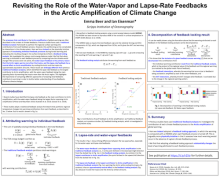Revisiting the Role of the Water Vapor and Lapse Rate Feedbacks in the Arctic Amplification of Climate Change
Ian
Eisenman
Scripps Institution of Oceanography, UC San Diego
Poster
The processes that contribute to the Arctic amplification of global surface warming are often described in the context of climate feedbacks. Many studies have used a traditional feedback analysis framework to partition the regional surface warming into contributions from each feedback process. However, this partitioning can be complicated by interactions in the climate system. In this talk, I will focus instead on the physically intuitive approach of inactivating individual feedback processes during forced warming and evaluating the resulting change in the surface temperature field. We investigate this using a moist energy balance model with spatially varying feedbacks that are specified from comprehensive climate model results. We find that when warming is attributed to each feedback process by comparing how the climate would change if the process were not active, the water vapor feedback is the primary reason that the Arctic region warms more than the tropics, and the lapse rate feedback has a neutral effect on Arctic amplification by cooling the Arctic and the tropics by approximately equivalent amounts. These results are strikingly different from previous feedback analyses, which identified the lapse rate feedback as the largest contributor to Arctic amplification, with the water vapor feedback being the main opposing factor by warming the tropics more than the Arctic region. This highlights the importance of comparing different approaches of analyzing how feedbacks contribute to warming in order to build a better understanding of how feedback processes influence climate changes.

eisenman-ian-polar-poster.pdf
(780.11 KB)
